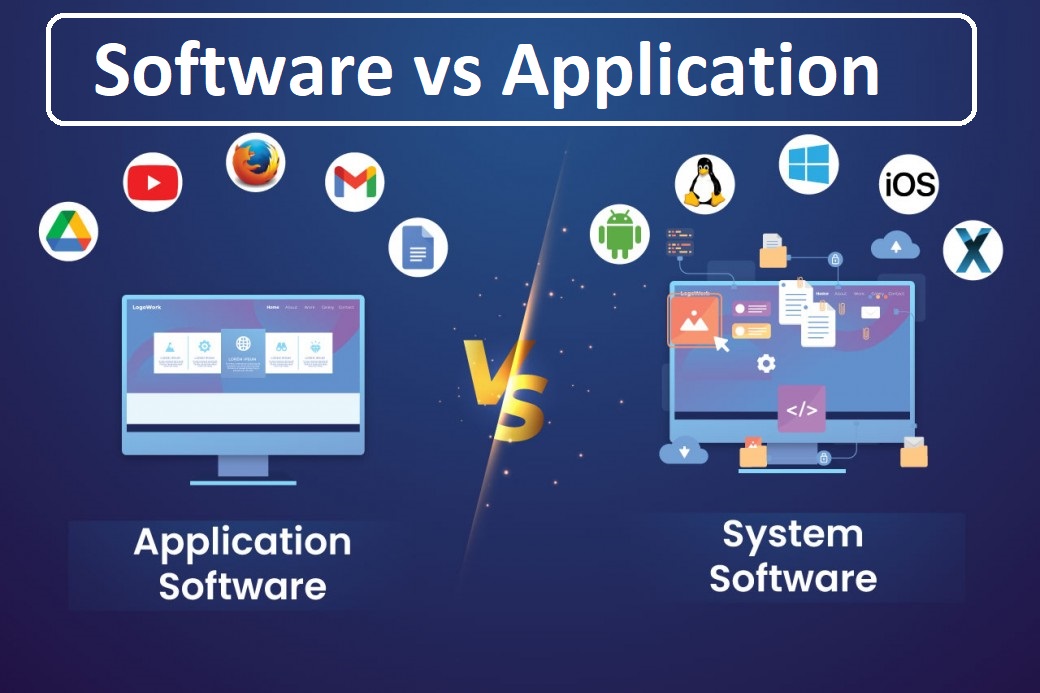Software vs Application: What’s the Difference?
In today’s fast-paced digital world, technology plays a central role in how we live, work, and communicate. Yet, many people still confuse common terms like software and application. While they are often used interchangeably, there are significant distinctions between the two that directly impact how businesses, organizations, and individuals use technology every day.
At the most basic level, software is a broad term that refers to the set of instructions or programs that tell a computer or device how to operate. Within this category, we find applications, which are specialized programs designed to perform specific tasks such as editing a document, browsing the internet, or managing business workflows. This means that all applications are software, but not all software qualifies as an application.
Understanding the difference between software and applications with examples is not just a technical curiosity — it’s an essential knowledge area for both businesses and consumers. For companies, this distinction helps in making strategic decisions about investing in system software, application development, or cloud-based solutions. For everyday users, it clarifies why some programs are essential for running a device, while others are optional tools for improving productivity, entertainment, or communication.
This guide dives deeper into software vs application in computers, highlights the unique characteristics of each, provides real-world examples, and explores which one is more important in today’s digital-first environment. Whether you’re a business leader seeking efficiency, a student learning computer science basics, or simply a tech enthusiast, understanding these differences will help you make smarter technology decisions.
What is Software?
Software is a broad and foundational term in computing that refers to a set of programs, instructions, and data that tell a computer how to function. Without software, hardware is simply an idle machine with no way to process information or perform tasks. Software essentially acts as the bridge between the user and the computer hardware, making it possible for people to interact with machines in meaningful ways.
Types of Software
Software is generally divided into two primary categories, each serving different purposes:
-
System Software
- This is the core software that powers a computer or device. It includes operating systems such as Windows, macOS, Linux, and Android, as well as utility programs that manage resources, control hardware, and ensure smooth communication between applications and hardware.
- For example, device drivers are a type of system software that allow hardware components like printers, keyboards, or graphics cards to function properly. Without system software, no applications could run.
- This refers to programs that are specifically designed to help users accomplish particular tasks. Examples include Microsoft Word for document creation, Google Chrome for browsing, Adobe Photoshop for image editing, or Spotify for streaming music.
- These applications rely on the underlying system software to function but focus solely on end-user needs such as productivity, communication, entertainment, or business management.
The Bigger Picture
In simple terms, software is the larger ecosystem, while applications are a subset within it. System software creates the environment in which application software can run, meaning both are equally important but serve different roles.
Real-World Importance of Software
- For businesses: Many companies invest in custom software development to improve scalability, manage operations, enhance cybersecurity, and integrate multiple systems into one efficient platform. Examples include enterprise resource planning (ERP) software or customer relationship management (CRM) systems.
- For individuals: Everyday users depend on system software like Android on smartphones or Windows on laptops to access the internet, use applications, and perform daily tasks with ease.
What is an Application?
An application (often shortened to app) is a type of software designed to perform specific tasks for the end-user. Unlike system software, which focuses on running and managing the computer itself, applications are built to solve particular problems, improve productivity, or provide entertainment. In essence, applications are the tools people interact with most directly in their daily lives.
Characteristics of Applications
- User-oriented: Applications are created with the end-user in mind, offering intuitive interfaces and task-driven features.
- Task-specific: Each application has a defined purpose — for instance, editing photos, sending messages, managing projects, or playing music.
- Easily manageable: Applications are typically easier to install, update, and uninstall compared to system software, which makes them more accessible to both individuals and businesses.
Types of Applications (with Examples)
-
Productivity Applications
- These applications are designed to enhance efficiency and organization in both personal and professional settings.
- Examples: Microsoft Word, Excel, PowerPoint, Notion, and Trello.
-
Mobile Applications
- Apps built for smartphones and tablets, often available through app stores like Google Play and Apple App Store.
- Examples: WhatsApp, Instagram, TikTok, and Candy Crush.
-
Web Applications
- Applications that run through a web browser, requiring no installation. They are often cloud-based, offering real-time collaboration.
- Examples: Google Docs, Slack, Zoom, and Canva.
-
Enterprise Applications
- Large-scale software applications developed to meet the needs of businesses and organizations.
- Examples: Salesforce (CRM), SAP (ERP), and Oracle NetSuite.
-
Entertainment and Media Applications
- Designed to provide fun, relaxation, or creative outlets.
- Examples: Netflix, Spotify, Steam, and Adobe Premiere Pro.
Importance of Applications in Daily Life and Business
- For individuals: Applications make it possible to shop online, connect with friends, manage finances, or learn new skills from a smartphone or computer.
- For businesses: Applications streamline operations, improve customer engagement, and increase productivity. For instance, a retail company might use a mobile app for online sales while employees use a project management app for internal tasks.
Key Differences Between Software and Application
| Aspect | Software | Application |
|---|---|---|
| Definition | General set of programs and instructions. | Specific program designed for user tasks. |
| Types | System software & application software. | A subset of software focused on end-user needs. |
| Usage | Manages resources, runs hardware, supports apps. | Helps users complete targeted activities. |
| Examples | Windows OS, Linux, Drivers. | MS Word, Facebook App, Spotify. |
This software vs application comparison chart clearly shows that while applications fall under the software category, their focus is more user-centric.
Software vs Application: Which is More Important?
When it comes to modern computing, asking “which is more important, software or application?” is like asking whether the foundation or the rooms are more important in a house. The truth is, both are essential, but they serve very different purposes.
Why Software is Important
- Foundation of computing: System software, such as Windows, macOS, or Linux, provides the operating environment that makes it possible to use any device at all.
- Resource management: Without system software, the computer cannot manage memory, storage, hardware devices, or security.
- Support for applications: Applications cannot run on their own. They rely on system software to communicate with the hardware and provide stability.
Example: Without Android (system software), you cannot run mobile apps like WhatsApp, Instagram, or Spotify.
Why Applications are Important
- Direct usability: Applications give end-users a way to perform tasks such as creating documents, editing photos, managing finances, or streaming music.
- Business functionality: From CRM systems like Salesforce to productivity apps like Microsoft Teams, applications empower businesses to increase efficiency, enhance customer relationships, and improve collaboration.
- Everyday life: Applications are what users interact with daily, whether it’s Netflix for entertainment, Zoom for video calls, or Google Docs for online collaboration.
Balanced Importance in Business and Daily Life
For businesses, software ensures operational stability, while applications drive customer-facing solutions. For example, a bank may rely on system software to secure its servers while using mobile applications to give customers access to online banking.
For individuals, both are equally important:
- Software makes sure the device works correctly.
- Applications allow people to use that device to communicate, shop, learn, or entertain themselves.
Similarities Between Software and Applications
Despite their differences, there are also similarities:
- Both are created using programming languages like Java, Python, or C++.
- Both rely on hardware to run efficiently.
- Both can be updated or upgraded to enhance performance.
- Both are essential to modern technology, from laptops to smartphones.
These similarities between software and applications highlight why people often confuse the two terms.
Which One Should You Focus on for Your Business?
For business leaders and entrepreneurs, the decision between investing in software or applications depends largely on company goals, industry demands, and customer needs. Both play critical roles, but the priority varies depending on what your business is trying to achieve.
When to Focus on Software Development
If your primary goals revolve around infrastructure, automation, scalability, and security, then investing in software development is the smarter move. Examples include:
- ERP systems for managing supply chains, accounting, and human resources.
- Custom software solutions for integrating multiple departments and streamlining workflows.
- System-level tools that handle data storage, cybersecurity, or server management.
📌 Example: A logistics company may prioritize developing custom software to track shipments in real time and optimize fleet management.
When to Focus on Application Development
If your focus is on end-user interaction, customer satisfaction, and employee productivity, then application development should be your priority. Applications provide the user-facing tools that directly solve problems and enhance experiences. Examples include:
- Mobile apps for online shopping, customer loyalty programs, or banking.
- Web applications for collaboration, e-learning, or cloud file management.
- Productivity apps that streamline internal business tasks such as project management or team communication.
📌 Example: A retail store might use a mobile application to engage customers with exclusive discounts while employees use a web app to manage inventory.
Why Most Businesses Need Both
The most competitive organizations invest in both software and applications to achieve balance:
- Software ensures the backend infrastructure works smoothly (databases, operating systems, and security).
- Applications create a customer-facing experience that drives engagement, sales, and satisfaction.
📌 Example: An e-commerce company may use enterprise software for inventory and payment processing while providing a mobile app that allows customers to browse, shop, and track orders.
Final Business Insight
Choosing between software and applications is not an either/or decision — it’s about strategic balance. Businesses that integrate both achieve stronger efficiency, scalability, and customer engagement, ultimately gaining a competitive edge in their industry.
Conclusion
While the terms software and application are closely related, they are not the same. Software provides the framework and backbone of computing systems, while applications deliver specific solutions to user needs. Recognizing the differences helps individuals choose the right tools and enables businesses to invest wisely in technology.
✅ Quick Summary:
- Software = The broader system.
- Applications = Specialized tools within the software category.
- Both are essential but serve different purposes.
Whether you are a business owner exploring software vs application for business growth or an individual trying to understand the difference between software and application in computers, knowing these distinctions ensures better decisions and improved productivity.




